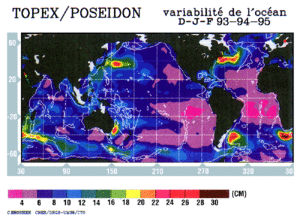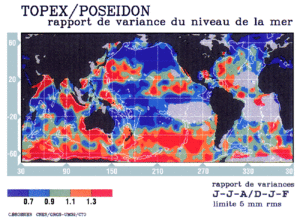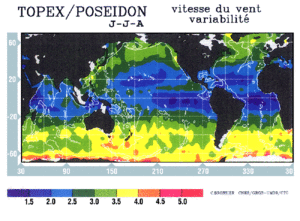Seasonal variations in sea level variability
J.F. Minster, C. Brossier (UMR39/GRGS, France)
TOPEX/POSEIDON data are unique for studying climatic variations in currents, but also useful for studying mesoscale variability, as they are less noisy and sampled more frequently and over longer periods than other altimeter data.
We analysed the seasonal variations in sea-level variability in three-month periods (December, January, February, refered to as D, J, F below) from three years of TOPEX/POSEIDON data (1993, 1994, 1995). The calculation was done using “enhanced” TOPEX/POSEIDON data (orbits, ocean tide and loading, sea-state bias and inverse barometer effect, etc.; see Minster et al., 1995). The geoid must be corrected forcross-track gradient effects. Variability was calculated relative to the mean over the period under consideration, filtering the seasonal signal from the steric height. The mean global variability was 8.1 cm rms in winter and summer, and 7.7 cm rms at mid- seasons. The details of the mesoscale variability map, well known thanks to GEOSAT, are confirmed by TOPEX/POSEIDON observations (see figure 1). The map reveals how important the instability of strong currents.
We calculated the ratios between the seasonal variances in the months D, J, F. Figure 2 shows the map of the ratio JJA/DJF (JJA = June, July, August), which is qualitatively comparable to the other two. At latitudes over 40 , the signal variance in winter is about 30% greater almost everywhere. This is also true in the Mediterranean. The notable exceptions are in the Antarctic Circumpolar Current, around 40 to 50 S, and in the South and North Atlantic between 40 and 50 latitude. However, in both hemispheres, the signal variance is at a maximum in the summer near the western boundary currents and in their recirculation areas. The expected effects can be seen in the Tropics: eddies off Somalia in the Arabian Gulf; North Equatorial Counter-Current in the Pacific. This seasonal variation in mesoscale variability confirms the GEOSAT results (Zlotnicki et al., 1982), but with better sampling. It should help us understand what drives current variability. Figure 2, without quantitative analysis, suggests different mechanisms in different areas.
At high latitudes, mesoscale variability could be affected by wind fluctuations. These show greater variance in winter than in summer at latitudes over 20 , except in the fifties. However, they are only significant in winter and at latitudes over 40 , where they exceed 3.5 cm rms (Figure 3). According to Frankignoul and Müller (1979), these stochastic wind fluctuations can induce eddies, mainly barotropic (Willebrandt et al., 1980). These lead to weak variations in sea level, which we expect to see only in areas of weak mesoscale energy.
The fact that mesoscale variability varies little with the seasons in strong currents is no surprise, since it is very difficult to significantly change the strong signal variance in these areas. The fact that the variance is higher in summer in subtropical gyres is more surprising. We would expect these mesoscale eddies to result from the propagation of baroclinic instability from western boundary currents. This seasonal variation may reflect the dissipation of greater potential energy in summer in these currents (in the Gulf Stream, transport by the jet and its southern recirculation is more significant in summer, according to Rogel, 1995). It may also be due to the north-south gradient of the potential vorticity, which is stronger in summer as a result of the developing pycnocline (Strass et al., 1992).
References
- Minster J-F., C. Brossier. Variation of the mean sea level from TOPEX/POSEIDON data. J. Geophys. Res., 100, in press (1995).
- Rogel P., Ph D Thesis,. Paul Sabatier University, Toulouse, 204 pp (1995).
- Strass V., H. Leach, J.D. Woods,. Deep-Sea Res., 39, 1627-1639 (1992).
- Willebrandt J., S.G.H. Philander, R.C. Pacanowski,. J. Phys. Oceanogr., 10, 411-429 (1980).
- Zlotnicki V., L. Fu, W. Patzert,. J. Geophys. Res., 94, 17,959-17,969 (1989).




















